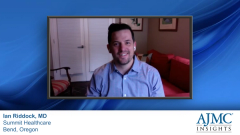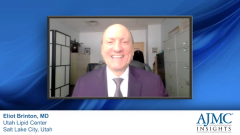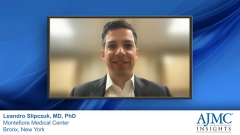
Therapy Beyond Statins in the Inpatient Setting
Dr Riddock explains how the ASCVD treatment landscape lends itself to initiation of therapy beyond statins in the inpatient setting.
Episodes in this series

Ian Riddock, MD: Within the inpatient setting when recognizing that somebody needs to go beyond statins and be initiated on additional therapy, it can be challenging. Part of this is because a lot of the inpatient formularies are lacking in the therapies that we need. Ezetimibe is likely to be on most hospital formularies. I have found that PCSK9 inhibitors are not. And it is difficult, therefore when we recognize that somebody is not on maximum LDL [low-density lipoprotein] lowering therapy for them to initiate it, and that needs to change. That in my opinion is one of the single biggest obstacles to getting these patients on the appropriate therapy. And then they oftentimes leave it to the outpatient follow up to address this. We do need to partner with pharmacists and administration in the hospitals to make it a more feasible for us to get these patients the therapy that they need. And they must understand why that is. There needs to be education on what we previously discussed about the quick separation of the Kaplan–Meier curve so that patients don’t come back with recurrent events.
When discussing intense lipid lowering therapy with patients, and that usually involves additional therapy beyond statins, because as we know, it is incredibly challenging to achieve these thresholds in the various guidelines with statin monotherapy. Then you’re talking to patients about adding on yet another medication. And to start with, I will say that there’s a lot of misinformation out there, unfortunately, on the internet or social media that aims to debunk or find alternative explanations for atherosclerosis than the LDL particle theory of atherosclerosis. And that is unfortunate. I do run in to patients that do want to improve their diet and their lifestyle which is great. And we should all be encouraging that, but unfortunately there’s a false sense of security in some of these patients that they feel that if they – if that’s all that they do, they can reverse or attenuate the risk. And they can attenuate the risk to a degree, but not to the degree that it’s likely or as likely to halt the progression of disease. And you often have to counsel them about various medications. Now, fortunately, we have good medications that are very safe. Ezetimibe inhibits intestinal absorption of cholesterol has very low adverse effect profile. The PCSK9 inhibitors, they are injectable medications which most of my patients find appealing because it’s an injectable thing every 2 weeks or once a month, and it’s not a pill that they have to take. And they don’t seem to have much of an issue with that. And when we talk about how clean the mechanism is as a monoclonal antibody, and then now we have other newer therapies that take advantage of small inhibiting messenger RNA technology where once you explain it to them and describe how it works, you do have to take the time to do that. They get it and they generally are accepting of it. The only drawback is cost and you have to kind of put that in its proper context. I do think it’s good that the American College of Cardiology has now started to talk about cost benefit in their guidelines. We as clinicians have shied away from that in the past, but if we engage in a discussion with them, especially right after acute coronary syndrome, you talk about a costly event. A trip to the hospital emergency room is incredibly expensive and that also serves though as a teachable moment. And when we talk about these therapies, there’s no better time to capture somebody’s attention than right after they’ve suffered an event. Unfortunately, they’re still alive and talking to you and hopefully had a pretty good outcome. But that is a teachable moment where you can talk about all these things and how wonderful the therapies are that we have available to them. That’s my approach for discussing all these therapies with these patients. I do feel that you need to educate them on the path of physiology and make at least an attempt to debunk some of the myth that’s out there.
This transcript has been edited for clarity.
Newsletter
Stay ahead of policy, cost, and value—subscribe to AJMC for expert insights at the intersection of clinical care and health economics.
































































